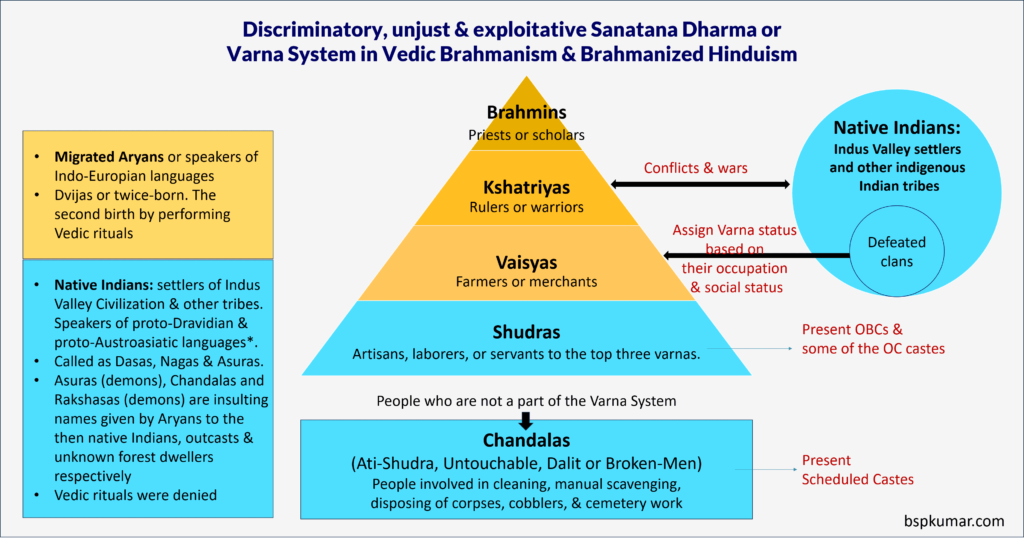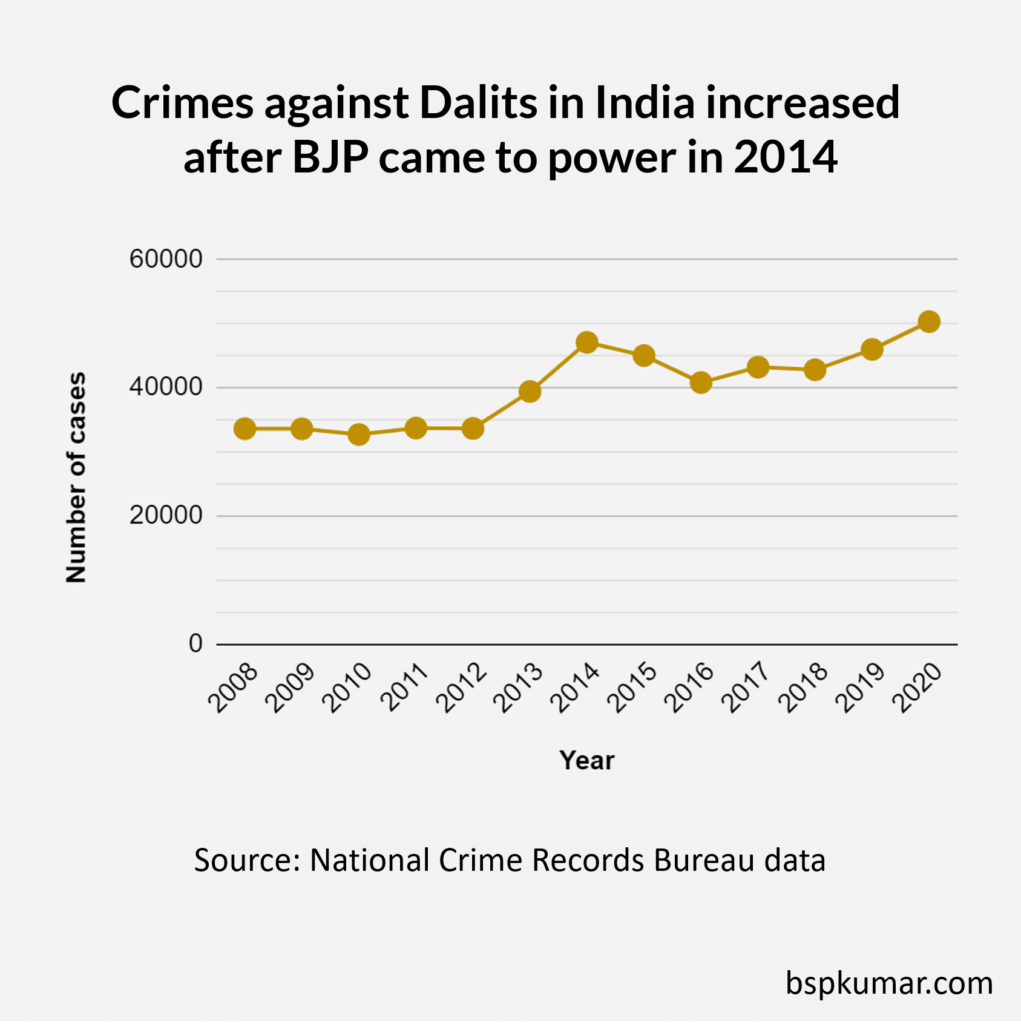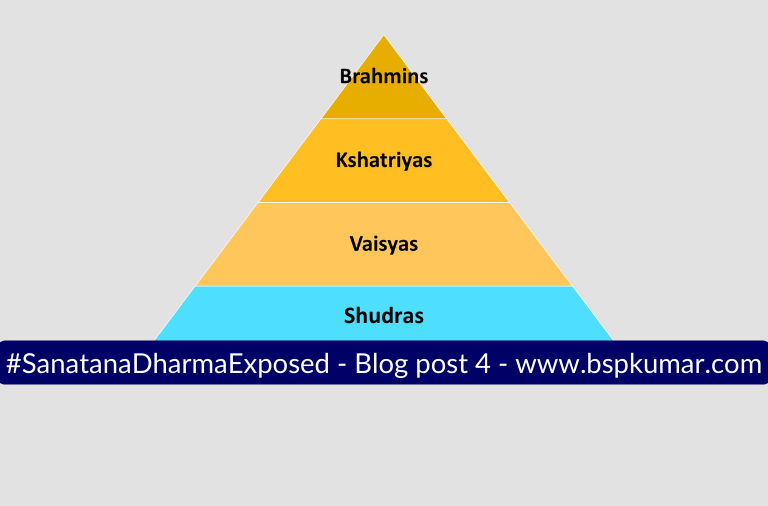Brahmanism is not just the dominance of Brahmins; it is the root cause of many socio-economic inequalities.
In this post, I discussed how Brahmanism, also known as Sanatana Dharma or Varna System, helped Brahmins dominate government sector jobs, private sector jobs, educational institutions, the judiciary, politics, sports, and most of the fields.
Most Indians think of the caste system as just caste discrimination or as a problem for just Dalits. But the caste system enforced by Brahmanism affects job and education opportunities; access to resources like land, wealth, knowledge, and social capital; personality development, and self-esteem; and many other personal, social, and economic aspects of most Indians.
Note: This is the fourth post in the blog post series that exposes Brahmanism, Sanatana Dharma, the Varna system, or caste system, which discriminates against 90% of Indians and is the root cause of many socio-economic issues in India. I suggest you read the remaining posts mentioned in the first post to have a comprehensive understanding of Sanatana Dharma.
The statistics are reflections of the Varna System and the dominance of Brahmins.
In the hierarchical Varna System, Brahmins occupy the top position and enjoy more resources and respect, and Dalits occupy the bottom position and enjoy no to less resources and are treated inhumanely as untouchables. The socioeconomic conditions of people from different castes in India still bear a strong resemblance to the Varna System, which is around 3,000 years old.


Image: Monthly per capita expenditure by caste according to a study1 conducted in Uttar Pradesh by Chhavi Tiwari and others.
The following statistics are the results of a study2 conducted by Ashoka University. The study empirically examined the justification for a slew of preferential policies aimed at Brahmins, the group unambiguously regarded at the top of the caste hierarchy, in three southern states of India.

Image: Differences in Material Standards of Living Across Groups in India according to the the Indian Human Development Survey 2011–12
Indicators: (i) per-capita household income measured in 10,000 of Rs.; (ii) per-capita consumption expenditure measured in 10,000 of Rs.; (iii) shareholding of professional jobs; (iv) share classified as non-poor; (v) share of households with access to some toilet facility; (vi) share of households who own or cultivate land.
The per capita income of Brahmins (58,200) is 2.35 and 3 times higher than that of non-Brahmin upper caste Hindus (24,700) and SC-ST castes (19,400)

Image: Differences in Human Capital Across Groups in India according to the the Indian Human Development Survey 2011–12.
Indicators: (i) years of schooling; (ii) share greater than 12 years of schooling; (iii) share literacy; (iv) share fluency in English; (v) share with some English ability; (vi) share of 8–11-year-olds that can read a paragraph or sentence; and (vii) the share of 8–11-year-olds who can divide or subtract.
30% of Brahmins hold a professional job, while the corresponding figures are 12% of non-Brahmin UC Hindus, 8% of OBCs, 6% of SC-STs, and 3% of Upper Caste Muslims.
Dominance of Brahmins in the corporate sector:

90% of the board of directors of the top 1000 companies listed on BSE belongs to two castes: 46.6% Vaishya and 44% Brahmin, according to a study conducted by The Economic & Political Weekly in 2012. 2% belongs to Kshatriya and other forward castes. The remaining 7.4% belong to all other castes, which make up over 90% of India’s population.
This is a discriminatory advantage they gained from caste-family connections and social networks they developed over the years. This is not purely based on merit. Most Indian corporate businesses are family-owned businesses, and most of the time the top management is hired from family-caste-social networks.
Dominance of Brahmins in government jobs
In a 1990 piece called “Brahmin Power”, the writer Khushwant Singh said: Brahmins form no more than 3.5% of the population of our country.
- Today, they hold as many as 70 percent of government jobs. I presume the figure refers only to gazetted posts.
- In the senior echelons of the civil service, from the rank of deputy secretaries upward, out of 500 there are 310 Brahmins, i.e., 63%;
- of the 26 state chief secretaries, 19 are Brahmins, i.e., 73%;
- of the 27 governors and lieutenant governors, 13 are Brahmins, i.e., 48%;
- of the 16 Supreme Court Judges, 9 are Brahmins, i.e., 56%;
- of the 330 judges of high courts, 166 are Brahminsi.e., 50%;
- of the 140 ambassadors, 58 are Brahmins, i.e., 41%;
- of the total 3,300 IAS officers, 2,376 are Brahmins, i.e., 72%;
- of the 508 Lok Sabha members, 190 were Brahmins, i.e., 37%;
- of the 244 in the Rajya Sabha members, 89 are Brahmins, i.e., 36%;
These statistics clearly prove that this 3.5% of the Brahmin community of India holds between 36% and 63% of all the plum jobs available in the country. How this has come about, I do not know. But I can scarcely believe that it is entirely due to the Brahmin’s higher IQ.”
This was how Brahmins were over-represented in all top government jobs before the introduction of OBC reservations in 1992. This was not entirely based on merit. It was pure discrimination.
I ask people who oppose reservations based on caste to think of how Brahmins would have stolen the jobs meant for giving adequate representation to backward communities. I’m pretty sure if we categorize the seats in educational institutions and jobs in government as Brahmin and non-Brahmin categories, many non-Brahmin candidates from OC castes will get much better representation.
Miscellaneous statistics on dominance of Brahmins and socio-economic inequality
Between 1960 and 1990, test-cricket-playing Indian teams averaged at least six Brahmins, sometimes even nine.
Six of the fifteen prime ministers of India were Brahmins (Jawaharlal Nehru, Indira Gandhi, Morarji Desai, Rajiv Gandhi, Narasimha Rao, and Atal Bihari Vajpayee). Modi, though an OBC, is a Brahminist as he supports Brahiminist Hindutva and Sanatana Dharma. In 76 years of rule after independence, Brahmins ruled for 51 years, upper castes ruled for 66 years, and Modi, a Brahmanist, will rule for 10 years by 2024.
40% of National Law School students in 1995 were Brahmins, who represent only 4% of the Indian population. In 1995, 77.5% of seats were filled without reservation. Other OC castes lost representation due to the over-representation of Brahmins. Imagine what would happen if there were no OBC reservations that exist today.
Sanatana Dharma and brutal discrimination and atrocities against Dalits:
- Every 15 minutes, a crime is committed against a Dalit.
- Every year, nearly 1000 Dalits were killed in caste-motivated atrocities.
- Every day, 6 Dalit women are raped.
Brahmanism and Untouchability
Practicing superstitious untouchability was banned in 1950, but it is still in practice in India. As mentioned in my other blog post, Brahmins started treating Dalits as untouchables in ancient India because Dalits embraced Buddhism and ate beef. Brahmins, who used to eat beef, gave up eating beef to counter Buddhism, which was against slaughtering animals for rituals. Untouchability practice is a mental illness that spreads from Brahmins to other castes and from Brahmanism to other religions.


Manual scavenging

Image: Johny, a manual scavenger by Reddit_PI
Johny, a 29-year-old manual scavenger, was working in a septic tank in Ghaziabad. He merely earns Rs. 300 ($4.05) a day to do this inhumane job
97% of manual scavengers in India are Dalits. The rest of them belong to the OBC and ST castes. Manual scavenging forces Dalits to manually clean, carry, or dispose of human excreta in an insanitary latrine, in an open drain sewer, or a septic tank. Although it was banned under the Prohibition of Employment of Manual Scavengers Act, of 2013, the inhumane practice continues.
Double discrimination by being a woman and a Dalit
On average, a Dalit woman dies 14 years younger than one from an upper caste. “Life expectancy among Dalit women is 11 years lower than that of higher caste women, despite experiencing identical social conditions like sanitation and drinking water.” The reason for this is that Dalit women work under exploitative working conditions due to their low level of education and status in the social hierarchy.
Crimes against Dalits, Muslims, and women increased after BJP came to power
Brahminists chose the Varna, or caste, as a strategic tool in Vedic Brahmanism and Brahmanized Hinduism to maintain the supremacy of Brahminists/Brahmins. Caste and gender discrimination are inherent in both religions.
The Brahminist RSS chose religion as a strategic tool in Hindutva while hiding its casteist nature. The RSS spreads hatred against and attacks Muslims and Christians to consolidate Hindu votes. Innocent Hindus from backward communities also become victims of these attacks, as they aren’t aware of the fake nationalist ideology of Hindutva.
BJP is a political wing of the Brahmanical RSS.


Attacks on Dalits increased by 27.3% and on tribals by 20.3% in 2018 after Modi came to power.
91% of hate crimes between 2009 and 2019 and 97% of violent incidents between 2010 and 2017 in the name of cow vigilance took place after Modi (RSS) came to power, according to the report released by Hate Crime Watch. Most of these crimes are against Dalits and Muslims.
69 people were killed in attacks on Muslims due to the Citizenship Amendment Act.
Some statistics on social issues caused by Sanatana Dharma
Only 6-10% of Indians had inter-caste marriages.
The number of inter-caste marriage killings (honor killings) increased from 28 to 251 between 2014 and 2016, a jump of 750% according to the Indian Human Development Survey (IDHS) 2014. Caste system will never cease to exist, and we will never unite as a nation as long as we restrict inter-caste marriages.

The female literacy rate among Christian, Hindu, and Muslim women is 81.5%. 64.3%, and 62%, respectively. One of the reasons for the low literacy rate among Hindu and Muslim women is the greater gender discrimination in Hinduism and Islam compared to other religions.
Footnotes
- Tiwari, C., Goli, S., Siddiqui, M. Z., & Salve, P. S. (2022). Poverty, wealth inequality and financial inclusion among castes in Hindu and Muslim communities in Uttar Pradesh, India. Journal of International Development, 34(6), 1227–1255. https://doi.org/10.1002/jid.3626
- Viewing Caste Inequality Upside Down - The Perversity of Special Schemes for Brahmins in South India - Ashwini Deshpande and Rajesh Ramachandran - October 2021 https://dp.ashoka.edu.in/ash/wpaper/paper67.pdf




